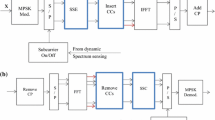Abstract
Cognitive Radio (CR) is a promising technique for the next generation mobile communication system for its capability to solve the conflicts between the scarcity and underutilization of spectrum. In this paper, aiming at maximizing the system capacity of a multi-antenna CR system on the premise that avoid interference to the primary system in the same band simultaneously, a resource allocation method which is able to avoid interference between PRimary (PR) and CR users by projecting the transmit signals of CR users on the null space of the PR users’ channels is proposed. CR users with better channel condition are selected, and the interference from CR system to PR users can be removed completely by projecting the transmit signals of CR system on the null-space of PR users’ channels. Parallel sub-channels are constructed for CR users through Singular Value Decomposition (SVD). At last, waterfilling is also adopted to increase the CR users’ capacity. Simulation result demonstrates that compared with existing methods, our method can improve the achievable sum rate of CR users as well as reduce the outage probability of PR users.
Similar content being viewed by others
References
Federal Communications Commission Spectrum Policy Task Force. Technical Report 02-135. Report of the spectrum efficiency working group. 2002.
J. Mitola. III and G. Q. Maguire, Jr. Cognitive radio: making software radios more personal. IEEE Personal Communications, 6(1999)4, 13–18.
I. F. Akyildiz, W. Y. Lee, M. C. Vuran, and S. Mohanty. NeXt generation/dynamic spectrum access/cognitive radio wireless networks: A survey. Computer Networks, Science Direct on Site, Elsevier, (2006)50, 2127–2159.
N. Prasad and X. D. Wang. Rate allocation in multiuser cognitive radio systems with successive group decoding. Information Theory and Applications Workshop Proceedings, San Diego, USA, Jan. 27–Feb. 1, 2008, 438–443.
R. Soundararajan and S. Vishwanath. Adaptive sum power iterative waterfilling for MIMO cognitive radio channels, IEEE International Conference on Communications Proceedings, Beijing, May 19–23, 2008, 1060–1064.
L. Zhang, Y. Xin, and Y. C. Liang. Weighted sum rate optimization for cognitive radio MIMO broadcast channels, IEEE International Conference on Communications Proceedings, Beijing, May 19–23, 2008, 3679–3683.
M. H. Islam, Y. C. Liang and A. T. Hoang. Joint beamforming and power control in the downlink of cognitive radio networks. IEEE Wireless Communications & Networking Conference Proceedings, Hong Kong, Mar. 11–15, 2007, 21–26.
L. Zhang, Y. C. Liang and Y. Xin. Joint beamforming and power allocation for multiple access channels in cognitive radio networks. IEEE Journal on Selected Areas in Communications, 26(2008)1, 38–51.
K. Hamdi, W. Zhang, and K. B. Letaief. Joint beamforming and scheduling in cognitive radio networks. IEEE Global Communications Conference, Washington, Nov. 26–30, 2007, 2977–2981.
K. Hamdi, W. Zhang, and K. B. Letaief. Low-complexity antenna selection and user scheduling in cognitive MIMO broadcast systems. IEEE International Conference on Communications Proceedings, Beijing, May 19–23, 2008, 4038–4042.
Q. H. Spencer, A. L. Swindlehurst, and M. Haard. Zero-forcing methods for downlink spatial multiplexing in multiuser MIMO channels. IEEE Transactions on Signal Processing, 52(2004)2, 461–471.
C. Zhang and L. Guo. BD Precoding schemes for cognitive MIMO system. IEEE International Conference on Network Infrastructure and Digital Content Proceedings, Shanghai, China, Mar. 29–Apr. 2, 2009, 11–15.
H. Y. Yi, H. L. Hu, Y. Rui, K. Q. Guo, and J. Zhang. Null space-based precoding scheme for secondary transmission in a cognitive radio MIMO system using second-order statistics. IEEE International Conference on Communications Proceedings, Dresden, Germany, Jun. 14–18, 2009, 1–5.
L. Bixio, G. Oliveri, M. Ottonello, M. Raffetto, and C. S. Regazzoni. Cognitive radios with multiple antennas exploiting spatial opportunities. IEEE Transactions on Signal Processing, 58(2010)8, 4453–4459.
R. Zhang and Y. C. Liang. Exploiting multi-antennas for opportunistic spectrum sharing in cognitive radio networks. IEEE Journal on Selected Topics in Signal Processing, 2(2008)1, 88–101.
J. M. Peha. Approaches to spectrum sharing. IEEE Communications Magazine, 43(2005)2, 10–12.
A. Ghasemi and E. S. Sousa. Capacity of fading channels under spectrum-sharing constraints. Proceedings IEEE International Conference Communications (ICC), Istanbul, Turkey, Jun. 2006, 4373–4378.
A. Goldsmith. Wireless Communications. Cambridge University Press, 2005, 109–111.
3rd Generation Partnership Project, RF System Scenarios, Technical Report 25.942-400, 2001.
Author information
Authors and Affiliations
Corresponding author
Additional information
Communication author: Zhu Shihua, born in 1950, male, Professor.
About this article
Cite this article
Mei, R., Shihua, Z. Null-space projection and waterfilling resource allocation in multi-antenna cognitive radio networks. J. Electron.(China) 27, 701–707 (2010). https://doi.org/10.1007/s11767-011-0504-1
Received:
Revised:
Published:
Issue Date:
DOI: https://doi.org/10.1007/s11767-011-0504-1




